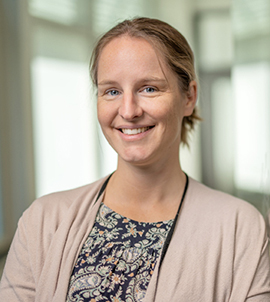Meet Lucie Delemotte, Professor in Computational Biophysics
Lucie Delemotte's journey into biophysics began with a fascination for molecular dynamics, leading her to a research focus on membrane proteins at KTH. Her work aims to understand cell communication, with potential applications in medicine, while she also juggles life with one-year-old twins.
What led you into biophysics?

"Back in France, at the universite of Lorraine, I started studying biology as an undergraduate, with a minor in chemistry. I became most fascinated by chemical reactions, and imagining how atoms and molecules met and assembled by wiggling and jiggling. During my Master's degree, I stumbled upon some research using molecular dynamics simulations. This technique made what I could only imagine in my head visible on the computer screen, and I couldn't believe it was even possible. I was hooked and decided to pursue a PhD in this area."
"Biophysics consists in applying methods from physics to problems in biology, and using quantitative methods to study life still sounds extremely appealing to me. I love that the area is interdisciplinary and that it is at the junction of physics, chemistry, and biology, but also, and increasingly, maths and artificial intelligence. Noone can make meaningful progress alone in this area, it requires collaboration, which agrees well with my personality and personal preferences."
Any important milestones on your way to becoming a professor?
"I was fortunate to be able to pursue my research interests with a lot of focus during my postdocs in Philadelphia and Lausanne before being recruited as an assistant professor at KTH. The starting package from SciLifeLab was very generous and enabled me to broaden my research interests and start recruiting and working with junior scientists who provided expertise that was complementary to mine. I am happy I immediately dared assemble a team of people with varied backgrounds and foster a stimulating yet friendly culture in the lab."
What is the focus of your research at the moment and what are its possible applications?
"We work on understanding the inner workings of membrane proteins, which are the molecular machines that make it possible for biological cells to communicate with their environment. For example, they transmit electric signals, receive hormonal signals, make it possible to sense smells or distinguish colors, or import nutrients like sugar molecules. When we understand these proteins in detail, we can understand when they are dysfunctional and cause diseases and even how to modify how they work by, for example, designing new medicines."
Apart from your new role, what else do you do?
"I have one-year-old twins, so watching them grow and guiding them through the process takes most of my time right now! Otherwise, I enjoy a lot being outside and discovering new places."
